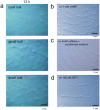Biological soliton in multicellular movement
- PMID: 23893301
- PMCID: PMC3725511
- DOI: 10.1038/srep02272
Biological soliton in multicellular movement
Abstract
Solitons have been observed in various physical phenomena. Here, we show that the distinct characteristics of solitons are present in the mass cell movement of non-chemotactic mutants of the cellular slime mould Dictyostelium discoideum. During starvation, D. discoideum forms multicellular structures that differentiate into spore or stalk cells and, eventually, a fruiting body. Non-chemotactic mutant cells do not form multicellular structures; however, they do undergo mass cell movement in the form of a pulsatile soliton-like structure (SLS). We also found that SLS induction is mediated by adhesive cell-cell interactions. These observations provide novel insights into the mechanisms of biological solitons in multicellular movement.
Figures





Similar articles
-
Modeling chemotactic cell sorting during Dictyostelium discoideum mound formation.Biophys J. 1999 Feb;76(2):595-605. doi: 10.1016/S0006-3495(99)77228-0. Biophys J. 1999. PMID: 9929466 Free PMC article.
-
Differentiation-inducing factor 2 modulates chemotaxis via the histidine kinase DhkC-dependent pathway in Dictyostelium discoideum.FEBS Lett. 2016 Mar;590(6):760-8. doi: 10.1002/1873-3468.12111. Epub 2016 Mar 4. FEBS Lett. 2016. PMID: 26919666
-
How amoeboids self-organize into a fruiting body: multicellular coordination in Dictyostelium discoideum.Proc Natl Acad Sci U S A. 2001 Mar 27;98(7):3879-83. doi: 10.1073/pnas.061535198. Proc Natl Acad Sci U S A. 2001. PMID: 11274408 Free PMC article.
-
Developmental decisions in Dictyostelium discoideum.Dev Biol. 2005 Aug 1;284(1):25-36. doi: 10.1016/j.ydbio.2005.05.011. Dev Biol. 2005. PMID: 15964562 Review.
-
Signal relay during the life cycle of Dictyostelium.Curr Top Dev Biol. 2006;73:115-40. doi: 10.1016/S0070-2153(05)73004-0. Curr Top Dev Biol. 2006. PMID: 16782457 Review.
Cited by
-
Polar pattern formation induced by contact following locomotion in a multicellular system.Elife. 2020 Apr 30;9:e53609. doi: 10.7554/eLife.53609. Elife. 2020. PMID: 32352381 Free PMC article.
-
Traveling pulse emerges from coupled intermittent walks: A case study in sheep.PLoS One. 2018 Dec 5;13(12):e0206817. doi: 10.1371/journal.pone.0206817. eCollection 2018. PLoS One. 2018. PMID: 30517114 Free PMC article.
-
A cell membrane model that reproduces cortical flow-driven cell migration and collective movement.Front Cell Dev Biol. 2023 Jun 23;11:1126819. doi: 10.3389/fcell.2023.1126819. eCollection 2023. Front Cell Dev Biol. 2023. PMID: 37427380 Free PMC article.
-
A Mutant of Dictyostelium discoideum, KI-Cell, as a Model of Collective Cell Migration Independent of Chemotaxis.Methods Mol Biol. 2024;2828:37-43. doi: 10.1007/978-1-0716-4023-4_4. Methods Mol Biol. 2024. PMID: 39147968
-
Collective cell migration of Dictyostelium without cAMP oscillations at multicellular stages.Commun Biol. 2019 Jan 24;2:34. doi: 10.1038/s42003-018-0273-6. eCollection 2019. Commun Biol. 2019. PMID: 30701199 Free PMC article.
References
-
- Lakshmanan M. Solitons, tsunamis and oceanographical applications of. in Extreme Environmental Events (ed Meyers, R. A.) 873–888 Springer, (2011).
-
- Hasegawa A. An historical review of application of optical solitons for high speed communications. Chaos 10, 475–485 (2000). - PubMed
-
- Sinkala Z. Soliton/exciton transport in proteins. J. Theor. Biol. 241, 919–927 (2006). - PubMed
-
- Yakushevich L. V. Is DNA a nonlinear dynamical system where solitary conformational waves are possible? J. Biosci. 26, 305–313 (2001). - PubMed
MeSH terms
Substances
LinkOut - more resources
Full Text Sources
Other Literature Sources
Molecular Biology Databases

